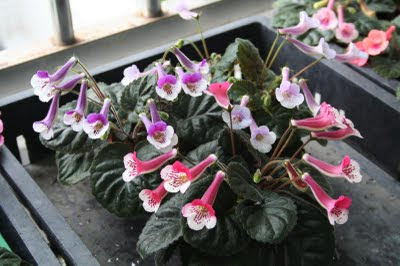| Sinningia 'Gabriel's Horn' grown by Gary's Specialty Plants |
Story # 12,
Sinningia ‘Gabriel’s Horn’ is in tissue culture production in the hope that big quantities can be sold.
Its flower is an example of what is called ‘double calyx’ or ‘hose in hose’. ‘Double calyx’ doesn’t explain everything. The corolla of the flower has extra petals that come from where the calyx normally grows. The ‘hose in hose’ comes from the look that a water hose is inside another hose when looked at from the front end.
All of this is of interest to plant collectors and important to Sinningia hybridizers. However, to the causal plant buyer, it only matters if the flower is pretty.
Nobody knows if ‘Gabriel’s Horn’ will be a successful commercial plant because there have never been sufficient quantities to find out.
It will be for sale at Longwood Gardens in eight to ten weeks.
It is a mid-sized mini Sinningia that is capable of high bud count and having many flowers open at once. With multiple flowering shoots coming off of the tuber, it can be spectacular.








